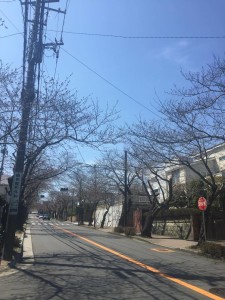In Japan, the academic year begins with cherry blossoms
29 Mar
The most special time of the year is finally here! Yes, it’s the season for ohanami, which means spring is here! It is a joyful event for almost everyone in Japan. Everywhere, people are talking about when to go for ohanami. I got an invitation, too!
Above: Cherry blossoms in Washington, DC, last Saturday
What is ohanami? Simple definition: hana = flower, and mi = miru = to see or watch. So ohanami literally means to see or enjoy flowers. But for Japanese people, it generally means to enjoy the sakura, or cherry blossom. (Ohanami is a politer form of hanami,,but both words mean the same thing.)
Historical documents show that Japanese people have enjoyed this special event since at least 1834. And yes, even the samurai (warriors) enjoyed the flowers!
What do we do at hanami? The main objective is to enjoy the flowers, but for some, it is also to have a drink or a picnic under the sakura trees.
Above: University of Toronto, St George (photo by Randy Landicho, used under CC BY 2.0 license)
Above: The University of Washington campus in Seattle on March 18, 2016 (photo by Joe Wolf, used under CC BY-ND 2.0 license)
Usually, the somei yoshino or cherry trees start blooming around late March. But most Japanese people start thinking about hanami long before that – even before they see the first flower blooming. The weather forecast doesn’t just tell you when the weather will get warmer, but also includes information about when the first cherry flowers are expected to bloom, and when they will blossom to the fullest.
The educational year in Japan closes at the end of March, and the new one starts in April, so our new school year starts with sakura. The sakura in full bloom is a symbol of spring and happiness. It also symbolizes celebration, so people often use the phrase sakura saku (the sakura bloomed) to say they passed their exams, especially school entrance exams.
I went to university in Kyoto (Japan’s imperial capital for about 1,000 years until the mid-1800s). I remember going for ohanami at the old imperial palace, which was right across from my university. It was a very special sight! Even without the cherry trees in full bloom, the palace draws tourists. With the sakura blossoms, there were even more tourists enjoying and cherishing the special view. I worked part-time at the imperial palace during ohanami time,selling disposable cameras to tourists. The cherry blossoms attract crowds, and people go everywhere for ohanami to enjoy the spring.
And luckily for me, the place where I live now is also famous for having lots of sakura trees. Soon, my neighborhood will turn light pink. The view from our windows is awesome! People come to enjoy the sight, and during the weekend we expect traffic jams, as many people try to drive through our streets to enjoy the view.
Above: My neighborhood on Monday, March 28. Below: last year at this time. Bottom: My son enjoying the flowers (photos by Rie Yamada)
Ohanami is a really special event in the year for Japanese people. I don’t think there is any religious significance for sakura or to cherish it – it’s just that this special sight of nature makes us happy!
By: Rie Yamada







The narrative by Rie Yamada captures one’s thoughts on nature’s bounty. Yamada’s writing, with images, describes the way cherry blossoms have created such a stunning metamorphosis to the environment. God gives us so much to look forward to. From-Deepak Rikhye.